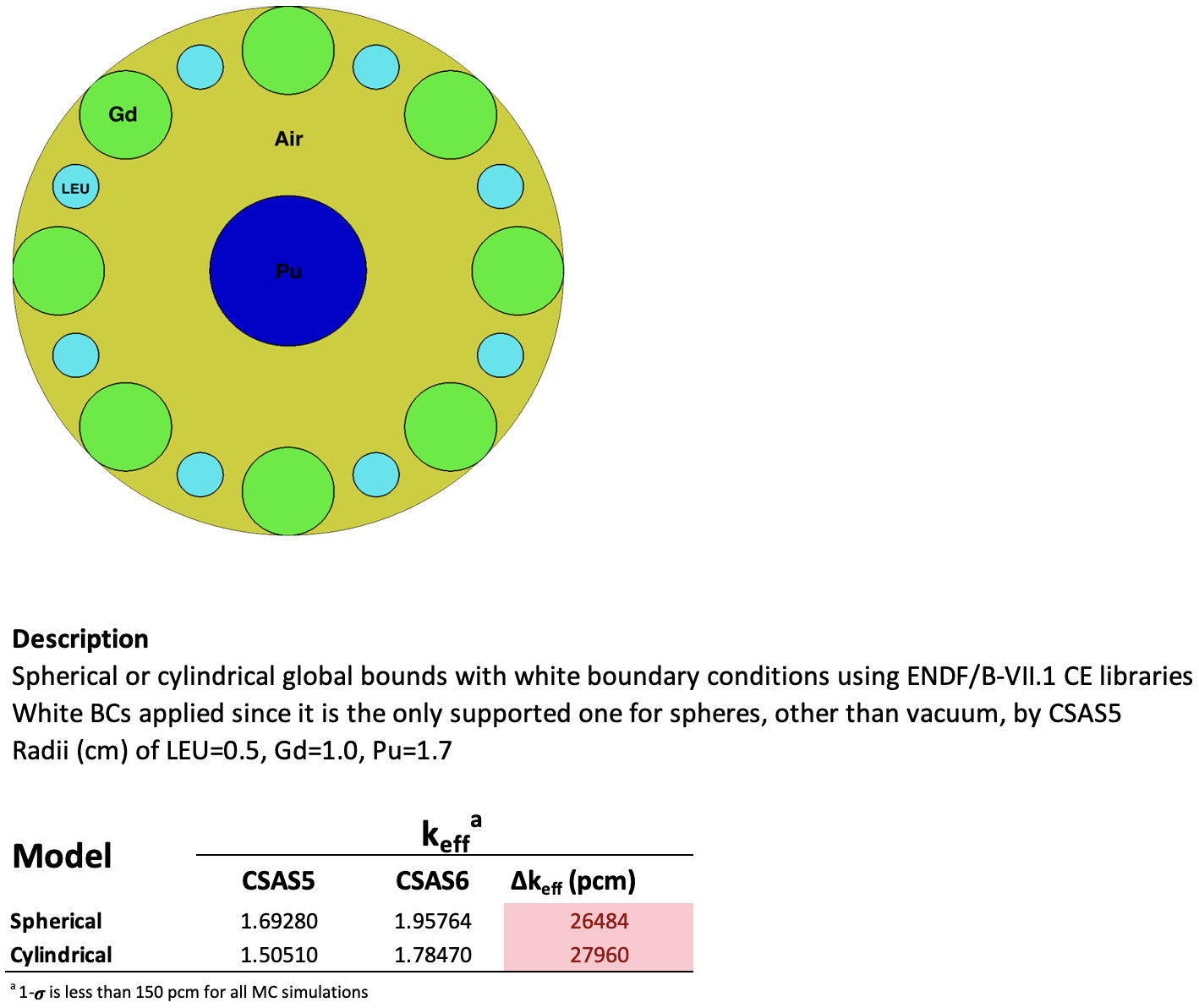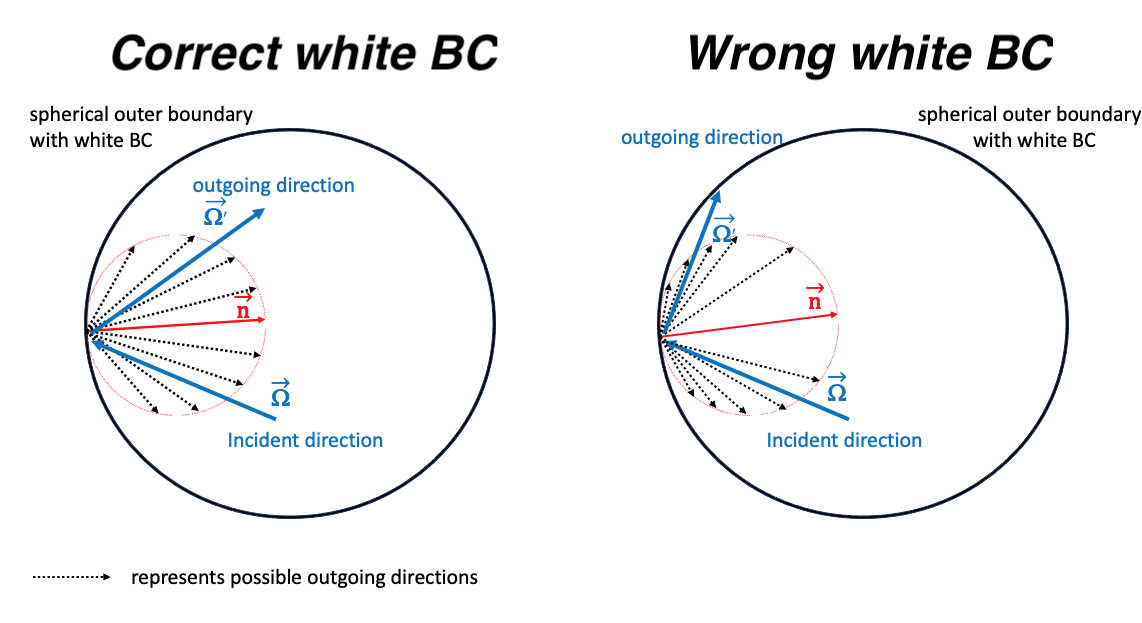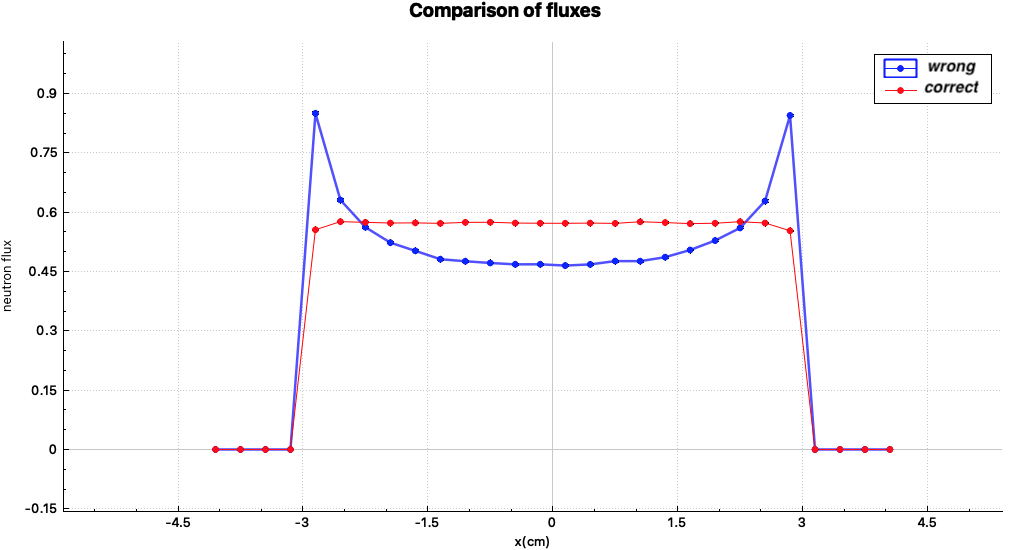SDL-2023-090#
Error in SCALE 6.3.0/6.3.1 CSAS5 with white boundary condition on curved surfaces has potential significant underprediction of keff.
Defect identifier |
|
Fix identifier |
N/A |
Fix deployed in production release |
v6.3.2 (projected) |
Fix deployed in beta release |
v7.0-beta09 (projected) |
Executive Summary#
A potentially high-impact software error was detected in v6.3.0-6.3.1 (also present in v6.2.0-6.2.2) regarding CSAS5 calculations with white boundary condition on a curved surface where the reflection angle is not sampled correctly. The bias is to sample away from the center of the geometry, leading to biased eigenvalues in heterogeneous systems with high neutron flux at the outer boundary surface. Note this issue is only present in current production release versions v6.3.0, v6.3.1 using CSAS5-KENO (not CSAS5-Shift), with white boundary conditions, on a cylindrical/spherical surface. Also, because it is related to boundary reflection, high leakage systems will be affected the most. The error will be fixed in v6.3.2.
Steps to Reproduce#
Run the CSAS5 model below and compare the keff of the system with a matching CSAS6 model or MCNP one.
=csas5
A cylindrical boundary
ce_v7.1_endf
read comp
' Pu
pu-239 1 0 0.037047 end
pu-240 1 0 0.0017512 end
pu-241 1 0 0.00011674 end
cu 1 0 0.0013752 end
' LEU
uo2 2 1 293 92235 5.0 92238 95.0 end
' absorber
gd 3 1 293 end
' air
dry-air 4 1 293 end
end comp
read geometry
unit 2
cylinder 2 1 0.5 2p50
unit 3
cylinder 3 1 1.0 2p50
global unit 4
cylinder 1 1 1.7 2p50
cylinder 4 1 6.0 2p51
'
hole 3 5.00000 0.00000 0.00000
hole 2 4.61940 1.9134 0.00000
hole 3 3.53553 3.53553 0.00000
hole 2 -4.61940 1.9134 0.00000
hole 2 1.91342 4.6194 0.00000
hole 3 0.00000 5.00000 0.00000
hole 2 -1.91342 4.6194 0.00000
hole 3 3.53553 -3.53553 0.00000
'
hole 3 -5.00000 0.00000 0.00000
hole 2 4.61940 -1.9134 0.00000
hole 3 -3.53553 3.53553 0.00000
hole 2 -4.61940 -1.9134 0.00000
hole 3 -3.53553 -3.53553 0.00000
hole 2 1.91342 -4.6194 0.00000
hole 3 0.00000 -5.00000 0.00000
hole 2 -1.91342 -4.6194 0.00000
'
end geometry
read parameters
gen=55 nsk=5 npg=10000 htm=no
end parameters
read bounds
SURFACE(1)=WHITE
end bounds
end data
end
What is the defective behavior?#
CSAS5 model underestimates keff by 25% (compared to CSAS6 without this issue) in this case.
Tested variations of a spherical system and a cylindrical system. See the table below for a brief description and calculated keff of the derived models.

concise.results#
What is the expected behavior?#
Good agreement between CSAS5 & CSAS6 among models. Correct white boundary reflection angle sampling.
Mitigation#
Is there a workaround?#
Modeling with CSAS5-Shift CSAS6. Alternatively, define a cuboidal global boundary around spherical or cylindrical systems and use the white boundary condition on the cuboidal boundary to resolve the issue.
Any additional notes on the scope of the defect?#
Using white boundary conditions on curvilinear shapes in KENO V.a is not recommended and might be required in rare circumstances. Possible interstitial or external moderators or reflector materials in real systems may reduce the impact of this issue down to ignorable levels in the results. The SCALE release up to 6.1.3 release doesn’t have this issue but SCALE 6.2.0 to 6.2.2 are susceptible to the same issue observed in SCALE 6.3.0 and SCALE 6.3.1 releases. SCALE 6.2.3 and 6.2.4 releases don’t have this issue because the global boundary shapes are limited to only cuboidal shapes for KENO V.a geometry definitions.
The white boundary condition is the only BC other than the vacuum BC for CSAS5 that uses KENO V.a geometry definitions. The impact of this issue, which originates from an erroneous sampling of particle directions from the white boundary, is adversely affected if a fissioning medium is surrounded by scattered absorbers around the periphery of the system with the white boundary condition in which the probability of absorption for scattered particles changes.
In KENO V.a geometry, although the polar and azimuthal angles were sampled correctly (from cosine distribution) when white BC was applied on a spherical surface, the reflected direction was not calculated correctly. The miscalculation of the direction vector reflected incident particles back to the locations close to the periphery of the spherical boundary as depicted in sketch below.

issue.details#
Incorrect boundary condition implementation affects both eigenvalue and tally results; mesh flux tally results can be easily visually assessed with Fulcrum. The figure below compares the flux values obtained from the KENO calculations before/after the fix implemented for a given problem applying white BC on the spherical outer boundary. As depicted in the figure, instead of showing a flat distribution, neutron flux shows max at the locations close to the spherical boundary and minimum at the center of the sphere.

flux.details#